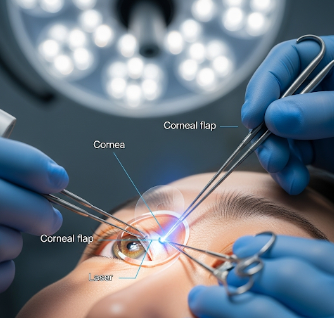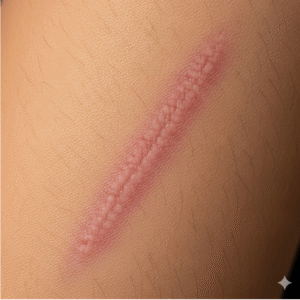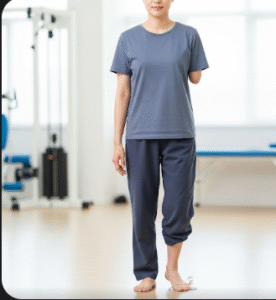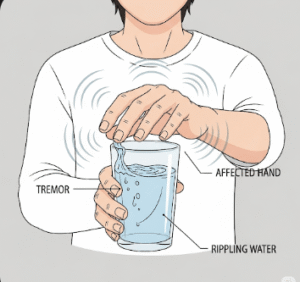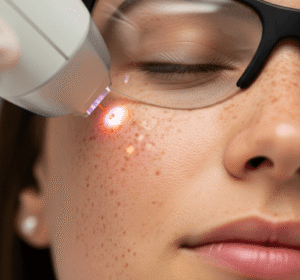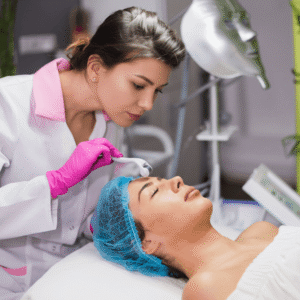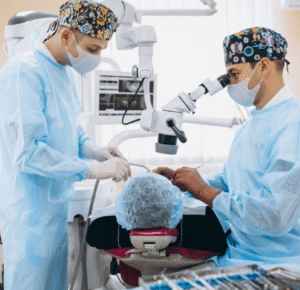Overview
LASIK Surgery (Laser-Assisted in Situ Keratomileusis) is a refractive eye surgery designed to correct vision problems such as myopia (nearsightedness), hyperopia (farsightedness), and astigmatism. The procedure reshapes the cornea using a laser to improve the eye’s focusing ability, often reducing or eliminating the need for glasses or contact lenses.
In Korea, LASIK is performed by experienced ophthalmic surgeons using state-of-the-art laser systems, ensuring precision, safety, and rapid recovery with minimal discomfort.
Highlights:
- ✅ Corrects myopia, hyperopia, and astigmatism
- ✅ Minimally invasive with rapid visual recovery
- ✅ Performed using advanced laser technology
What is LASIK Surgery?
LASIK Surgery involves creating a thin flap on the cornea, lifting it, and reshaping the underlying corneal tissue with an excimer laser. The flap is then repositioned, allowing the eye to focus light accurately on the retina, thereby improving vision.
Indications include:
- Myopia (nearsightedness)
- Hyperopia (farsightedness)
- Astigmatism
- Patients seeking reduced dependence on glasses or contact lenses
Important: LASIK is typically recommended for adults with stable vision and healthy corneas. Preoperative evaluation ensures candidacy and minimizes risks.
What are the benefits?
- Improved vision: Many patients achieve 20/20 vision or better
- Quick recovery: Most notice significant improvement within 24–48 hours
- Reduced dependence on corrective lenses: Glasses or contact lenses often no longer required
- Minimally invasive: Outpatient procedure with minimal discomfort
Key benefits highlighted:
- ⚡ Rapid visual improvement
- ⚡ Painless with advanced numbing techniques
- ⚡ Safe with high success rates in qualified patients
- ⚡ Long-term vision correction for eligible candidates
Procedure Details
1) How should I prepare for LASIK Surgery?
- Preoperative evaluation: Comprehensive eye examination including corneal thickness, refractive error measurement, and retinal health
- Medication and lens review: Stop using contact lenses for a period before surgery
- Consent and education: Understand procedure, risks, expected outcomes, and recovery process
- Lifestyle preparation: Arrange transportation for the day of surgery; avoid eye makeup or creams
- Health considerations: Discuss any medical conditions or medications with the ophthalmologist
2) What happens during LASIK Surgery?
- Anesthesia: Numbing eye drops applied for pain-free procedure
- Flap creation: Laser or microkeratome used to create a thin corneal flap
- Corneal reshaping: Excimer laser reshapes the cornea to correct refractive error
- Flap repositioning: Corneal flap placed back without stitches; begins natural healing immediately
Duration: Typically 15–30 minutes for both eyes
3) What happens after LASIK Surgery?
- Immediate recovery: Rest in the clinic for a short period; vision may be blurry initially
- Postoperative care: Antibiotic and anti-inflammatory eye drops prescribed
- Activity: Avoid rubbing eyes, swimming, or strenuous activity for a few weeks
- Follow-up care: Regular check-ups to monitor healing and visual acuity
Highlights for post-procedure care:
- ⚡ Expect mild dryness, light sensitivity, or temporary glare
- ⚡ Use prescribed eye drops diligently
- ⚡ Avoid eye trauma or rubbing the eyes
- ⚡ Attend all follow-up appointments to ensure optimal healing
Risks / Benefits
Risks:
- Dry eyes or temporary discomfort
- Glare, halos, or starbursts around lights, especially at night
- Under- or over-correction requiring enhancement
- Rare complications: infection or flap issues
Benefits:
- Rapid vision improvement with minimal discomfort
- High success rate in suitable candidates
- Minimally invasive outpatient procedure
- Long-term reduction in dependence on glasses or contacts
Recovery and Outlook
- Hospital stay: Outpatient; no overnight stay required
- Full recovery: Visual stabilization usually within 1–4 weeks
- Long-term outlook: Excellent for properly selected candidates; most achieve significant vision improvement
- Follow-up: Postoperative appointments at 1 day, 1 week, and 1 month; additional checks if needed
Tips for optimal recovery:
- ✅ Avoid rubbing eyes and follow all drop regimens
- ✅ Wear protective eyewear as advised
- ✅ Avoid swimming or dusty environments for 2–4 weeks
- ✅ Attend all scheduled follow-up visits
When To Call the Doctor
- Persistent redness, pain, or vision changes
- Excessive tearing or discharge
- Sudden loss of vision or blurred vision not improving
- Sensitivity to light or halos that worsen unexpectedly
Best Korea Option / Process
Korea provides advanced LASIK surgery care:
- Top hospitals: Specialized ophthalmology centers with highly experienced surgeons
- Advanced diagnostics: Corneal mapping, wavefront analysis, and pupil assessment
- State-of-the-art lasers: Precise excimer and femtosecond laser technology
- Postoperative care: Follow-up visits, medication, and guidance for visual recovery
- International patient support: Online consultations, appointment scheduling, and telemedicine follow-up
Step-by-step process in Korea:
- Online consultation and preoperative eye examination
- Pre-surgery instructions and preparation
- LASIK procedure using advanced laser technology
- Immediate postoperative monitoring and discharge
- Follow-up visits to ensure proper healing and optimal visual outcomes

